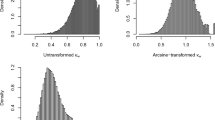Abstract
Suppose two judges each classify a group of objects into one of several nominal categories. It has been observed in the literature that, for fixed observed agreement between the judges, Cohen’s kappa penalizes judges with similar marginals compared to judges who produce different marginals. This paper presents a formal proof of this phenomenon.
Similar content being viewed by others
References
AICKIN, M. (1990), “Maximum Likelihood Estimation of Agreement in the Constant Predictive Model, and Its Relation to Cohen’s Kappa,” Biometrics, 26, 293–302.
BAKEMAN, R., QUERA, V., MCARTHUR, D., and ROBINSON, B.F. (1997), “Detecting Sequential Patterns and Determining Their Reliability with Fallible Observers,” Psychological Methods, 2, 357–370.
BRENNAN, R.L., and PREDIGER, D.J. (1981), “Coefficient Kappa: Some Uses, Misuses, and Alternatives,” Educational and Psychological Measurement, 41, 687–699.
BYRT, T., BISHOP, J., and CARLIN, J.B. (1993), “Bias, Prevalence and Kappa,” Journal of Clinical Epidemiology, 46, 423–429.
CICCHETTI, D.V., and FEINSTEIN, A.R. (1990), “High Agreement but Low Kappa: II. Resolving the Paradoxes,” Journal of Clinical Epidemiology, 43, 551–558.
COHEN, J. (1960), “A Coefficient of Agreement for Nominal Scales,” Educational and Psychological Measurement, 20, 213–220.
CONGER, A.J. (1980), “Integration and Generalization of Kappas for Multiple Raters,” Psychological Bulletin, 88, 322–328.
DE MAST, J. (2007), “Agreement and Kappa-Type Indices,” The American Statistician, 61, 149–153.
DOU, W., REN, Y., WU, Q., RUAN, S., CHEN, Y., BLOYET, D., and CONSTANS, J.-M. (2007), “Fuzzy Kappa for the Agreement Measure of Fuzzy Classifications,” Neurocomputing, 70, 726–734.
GUGGENMOOS-HOLZMANN, I. (1996), “The Meaning of Kappa: Probabilistic Concepts of Reliability and Validity Revisited,” Journal of Clinical Epidemiology, 49, 775–783.
GWET, K.L. (2008), “Computing Inter-rater Reliability and Its Variance in the Presence of High Agreement,” British Journal of Mathematical and Statistical Psychology, 61, 29–48.
FEINSTEIN, A.R., and CICCHETTI, D. V. (1990), “High Agreement but Low Kappa: I. The Problems of Two Paradoxes,” Journal of Clinical Epidemiology, 43, 543–549.
GOODMAN, L.A. (1991), “Measures, Models, and Graphical Displays in the Analysis of Cross-classified Data,” Journal of the American Statistical Association, 86, 1085–1111.
HARDY, G.H., LITTLEWOOD, J. E., and PÓLYA, G. (1988), Inequalities (2nd ed.), Cambridge: Cambridge University Press.
HUBERT, L. (1977), “Kappa Revisited,” Psychological Bulletin, 84, 289–297.
HUBERT, L.J., and ARABIE, P. (1985), “Comparing Partitions,” Journal of Classification, 2, 193–218.
KRAEMER, H.C. (1979), “Ramifications of a Population Model for κ as a Coefficient of Reliability,” Psychometrika, 44, 461–472.
KRAEMER, H.C., PERIYAKOIL, V.S., and NODA, A. (2004), “Tutorial in Biostatistics: Kappa Coefficients in Medical Research,” Statistics in Medicine, 21, 2109–2129.
LANTZ, C.A., and NEBENZAHL, E. (1996), “Behavior and Interpretation of the κ Statistic: Resolution of the Paradoxes,” Journal of Clinical Epidemiology, 49, 431–434.
LIPSITZ, S.R., LAIRD, N.M., and BRENNAN, T.A. (1994), “Simple Moment Estimates of the κ-Coefficient and Its Variance,” Applied Statistics, 43, 309–323.
MARTÍN ANDRÉS,A. and FEMIAMARZO, P. (2004), “Delta: A NewMeasure of Agreement Between Two Raters,” British Journal of Mathematical and Statistical Psychology, 57, 1–19.
MARTÍN ANDRÉS, A. and FEMIA MARZO, P. (2008), “Chance-corrected Measures of Reliability and Validity in 2 × 2 Tables,” Communications in Statistics, Theory and Methods, 37, 760–772.
NELSON, J.C., and PEPE, M.S. (2000), “Statistical Description of Interrater Variability in Ordinal Ratings,” Statistical Methods in Medical Research, 9, 475–496.
SIM, J., and WRIGHT, C.C. (2005). The Kappa Statistic in Reliability Studies: Use, Interpretation, and Sample Size Requirements, Physical Therapy, 85, 257–268.
STEINLEY, D. (2004), “Properties of the Hubert-Arabie Adjusted Rand Index,” Psychological Methods, 9, 386–396.
THOMPSON, W.D., and WALTER, S.D. (1988), “A Reappraisal of the Kappa Coefficient,” Journal of Clinical Epidemiology, 41, 949–958.
VACH,W. (2005), “The Dependence of Cohen’s Kappa on the Prevalence Does not Matter,” Journal of Clinical Epidemiology, 58, 655–661.
VON EYE, A., and VON EYE, M. (2008), “On the Marginal Dependency of Cohen’s κ,” European Psychologist, 13, 305–315.
WACKERLY, D.D., and ROBINSON, D.H. (1983), “A More Powerful Method for Testing Agreement Between a Judge and a Known Standard,” Psychometrika, 48, 183–193.
WARRENS, M.J. (2008a), “On Similarity Coefficients for 2 × 2 Tables and Correction for Chance,” Psychometrika, 73, 487–502.
WARRENS, M.J. (2008b), “On the Equivalence of Cohen’s Kappa and the Hubert-Arabie Adjusted Rand Index,” Journal of Classification, 25, 177–183.
WARRENS, M.J. (2008c), “On Association Coefficients for 2 × 2 Tables and Properties That Do Not Depend on the Marginal Distributions,” Psychometrika, 73, 777–789.
WARRENS, M.J. (2008d), “On the Indeterminacy of Resemblance Measures for (Presence/Absence) Data,” Journal of Classification, 25, 125–136.
WARRENS, M.J. (2008e), “Bounds of ResemblanceMeasures for Binary (Presence/Absence) Variables,” Journal of Classification, 25, 195–208.
WARRENS, M.J. (2009), “k-Adic Similarity Coefficients for Binary (Presence/Absence) Data,” Journal of Classification, 26, 227–245.
WARRENS, M.J. (2010), “Inequalities Between Kappa and Kappa-like Statistics for k × k Tables,” Psychometrika, 75, 176–185.
ZWICK, R. (1988), “Another Look at Interrater Agreement,” Psychological Bulletin, 103, 374–378.
Author information
Authors and Affiliations
Corresponding author
Rights and permissions
About this article
Cite this article
Warrens, M.J. A Formal Proof of a Paradox Associated with Cohen’s Kappa. J Classif 27, 322–332 (2010). https://doi.org/10.1007/s00357-010-9060-x
Published:
Issue Date:
DOI: https://doi.org/10.1007/s00357-010-9060-x




